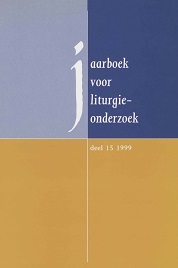De verhouding tussen het pionierswerk van H.W. Creutzberg en de Liturgische Kring
Abstract
The subject of this article is the relationship between H.W. Creutzberg (1875 - 1940) and the ‘Liturgische Kring’, The ‘Liturgische Kring’ was founded in Creutzberg’s parish church, the ‘Duinoordkerk’, most probably a year after its consecration in December 1920. Apart from some publications, up to now little was known about the first decades of the ‘Liturgische Kring’. The archives of Creutzberg”s parish, the ‘Duinoordkerkgemeente’, however, afford an insight into this period now. Just like the pioneer J.H. Gerretsen, Creutzberg was influenced in his view on liturgy by the orthodox reformed A. Kuyper as well as by the methodist tradition. In addition a strong aesthetical accent can be determined, especially in his approach of church buildings and church interiors. In the ‘Duinoordkerk’ aestheticism got the upper hand. Initially Creutzberg left a strong mark on the liturgy of the ‘Duinoordkerk’, but after some time his influence decreased and the liturgy froze. Though the congregation of ‘Duinoord’ was known for its innovative spirit, it showed itself to be quite traditional in the second decade of its existence. Creutzberg himself also became reluctant in the last years of his life. As his reputation grew, the number of occupations outside his parish increased, while his health worsened. Without any doubt the liturgy of the ‘Duinoordkerk’ has inspired the ‘Liturgische Kring’. Its ideals were put into practice here and the congregation of the ‘Duinoordkerk’ regularly put questions to the ‘Liturgische Kring’, for example about the nature of the office or about the layout of a service in remembrance of the deceased. Within a decade, however, each went his own way. A comparison of the in 1934 published Handboek voor den Eeredienst with the actual liturgical practice of the ‘Duinoordkerk’ shows us the latter is not trendsetting anymore. Though the congregation of the ‘Duinoordkerk’ was still uncommon in many respects, its leading role in the renewal of the liturgy was over.


